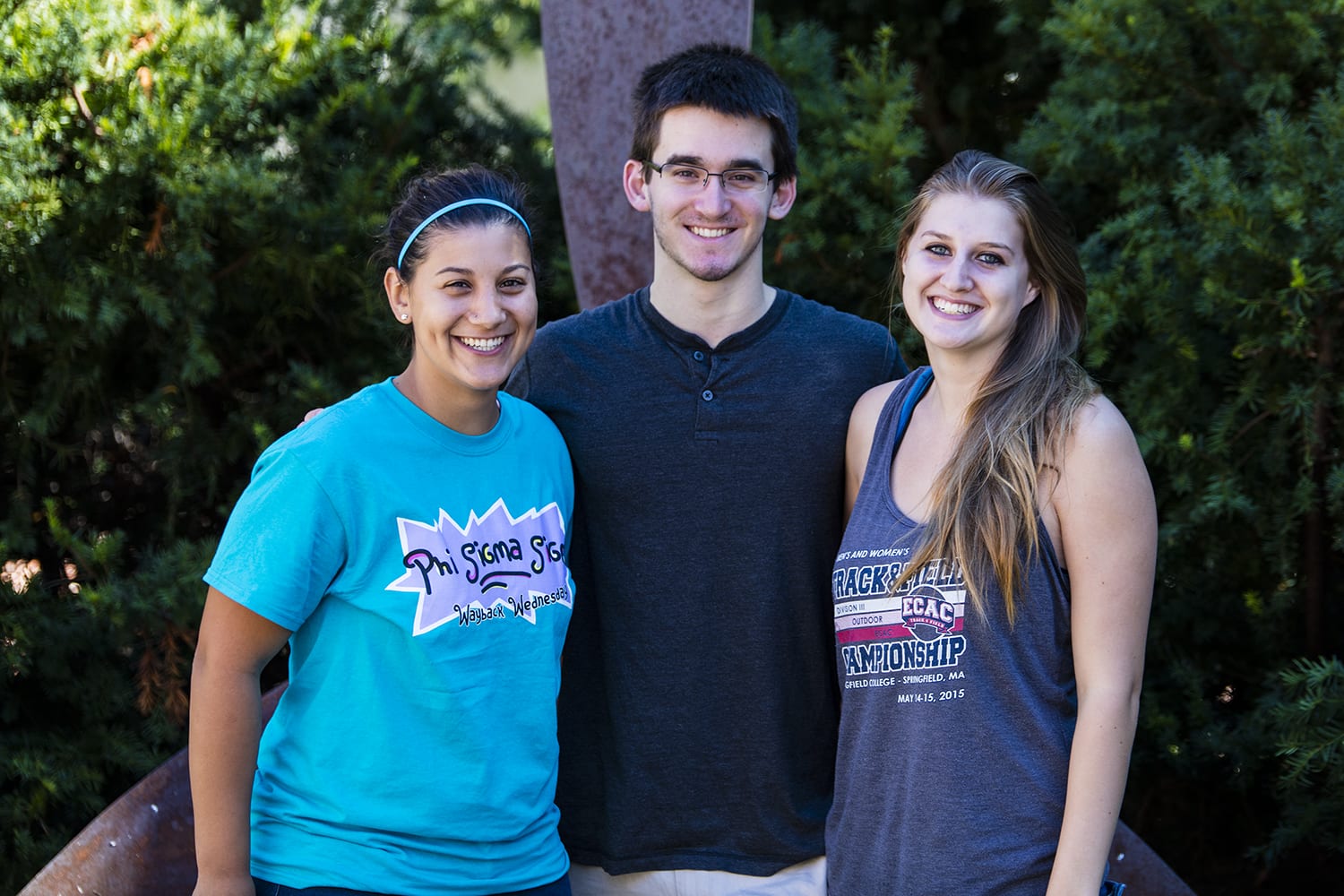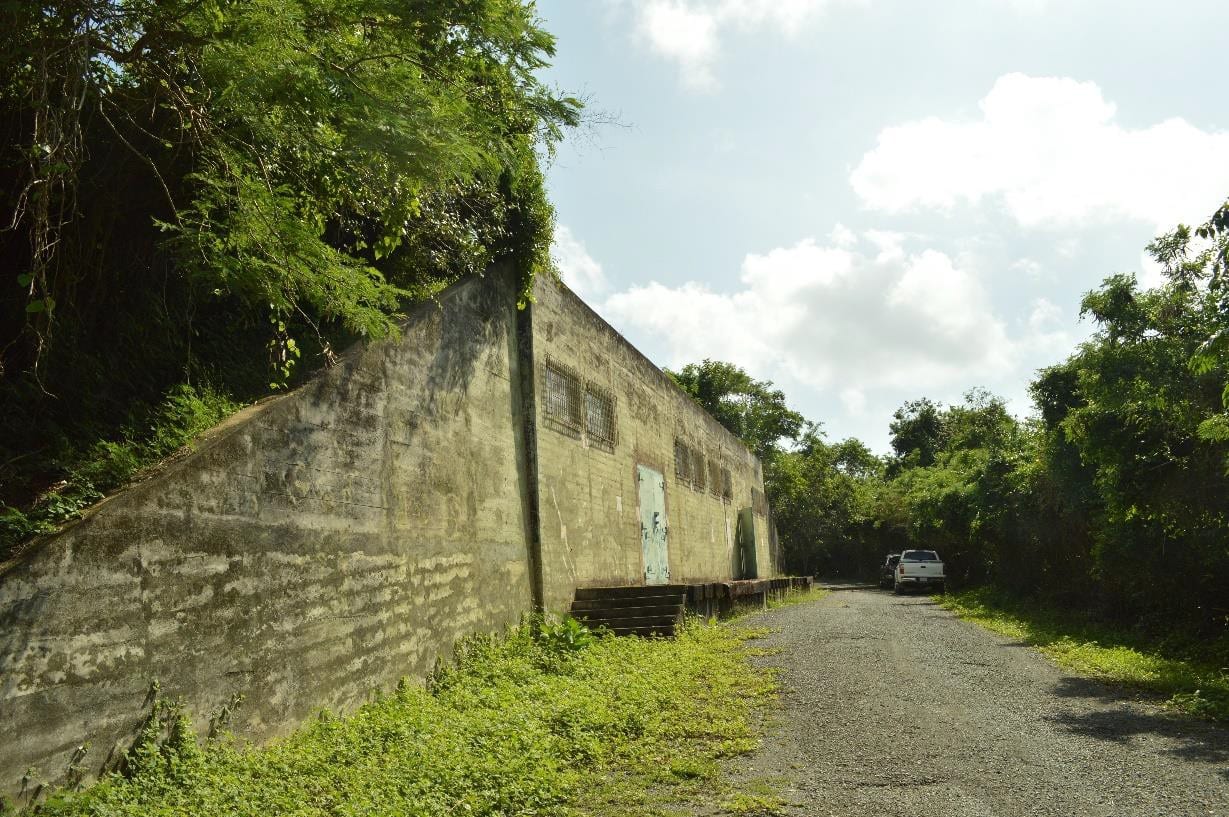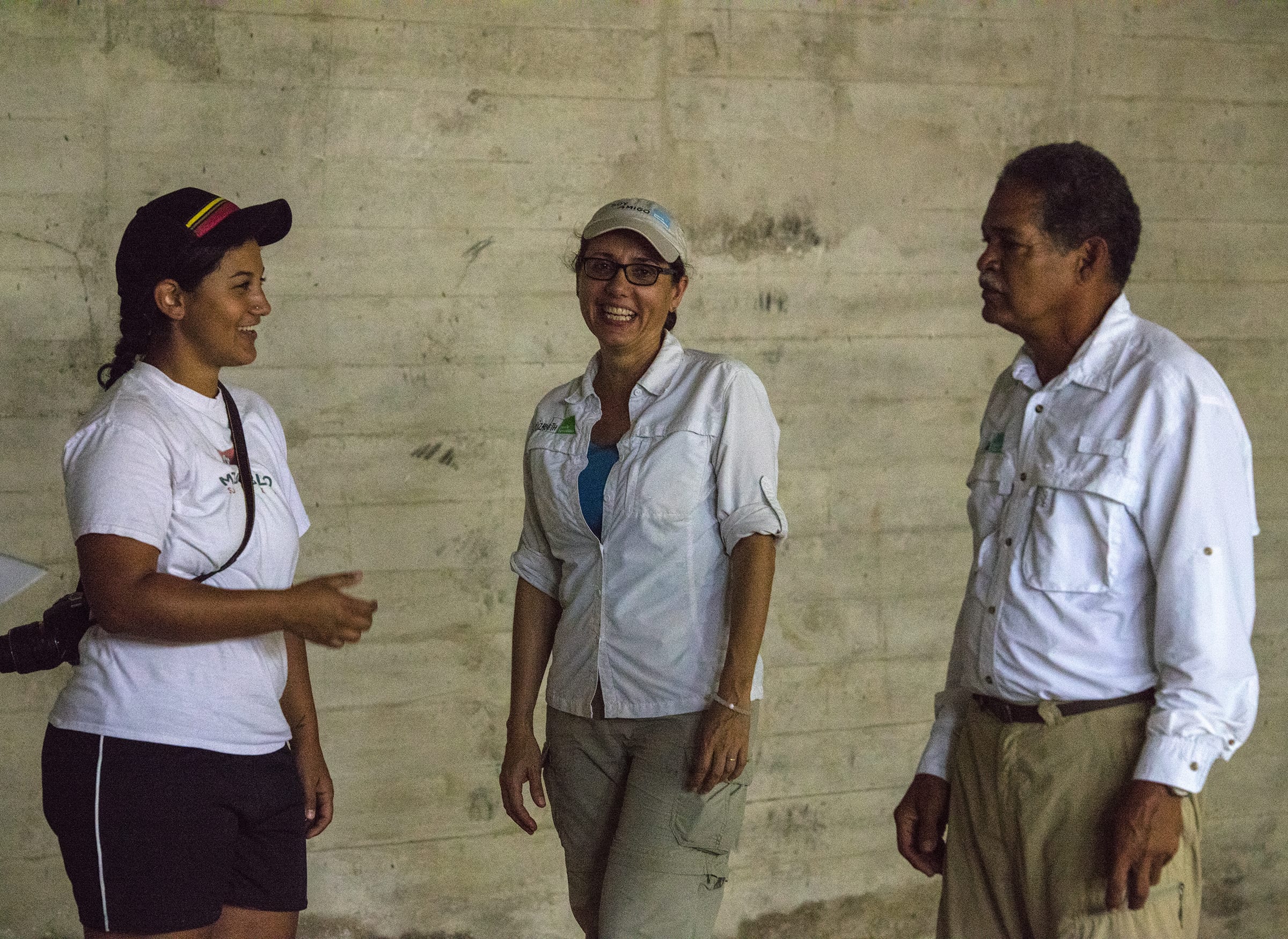Repurposing Retired Navy Bunkers in Vieques, Puerto Rico
 Sponsoring organization: Para la Naturaleza
Sponsoring organization: Para la Naturaleza
Team members: Sarah Muse (Chemical Engineering ’17), Serena Soltero (Civil Engineering ’17), Matt Suarez (Computer Science ’17)
Executive Summary: Vieques is a small island off the coast of Puerto Rico and, like Puerto Rico, is in the midst of an economic crisis. Unemployment and poverty rates are extremely high. The economic situation on Vieques has remained the same for decades. Prior to the 1940’s Vieques had a booming economy primarily based in the sugar trade. In the early 1940’s the United States Navy purchased two-thirds of the island forcing the economy to change; the people no longer had enough land for agriculture. However, the Navy’s presence opened up jobs in construction and in restaurants and bars. This sustained the economy for a few years, but when the focus of World War II moved out of the Caribbean theater, construction stopped and there were not enough sailors stationed on the island to support the local businesses. This left the island with no source of income or jobs. The Navy maintained ownership of the land until 2003 when they left after years of protests by the Viequenses. Today the land is owned by US Fish and Wildlife and the people still cannot return to their agriculture roots.
Our sponsor Para la Naturaleza came up with the idea of converting bunkers left by the Navy into an agricultural facility to create more jobs on the island. The goal of our project was to determine if this farm could be a self-sustainable business that provides employment opportunities in Vieques. We designed a schematic for the bunkers which included a floor plan, a renewable energy and water collection system, analyzed the economic cost of the investment and operation of the facility, and assessed the needs and interests of the community.
Methods:
We broke our project up into three objectives, engineering, economics and community support. Then the feasibility of each was assessed separately by:
- Evaluating the engineering aspect of such a facility by estimating water usage, determining electrical consumption, and creating a process to grow mushrooms
- Assessing the economic feasibility of a mushroom facility and computing the amount of jobs that could be provided
- Weighing the social impact of the facility by gauging community attitude, support from the community and government.
We began by looking at the engineering aspect of a mushroom farm. To start, the bunkers have no electricity or running water. We did research on renewable energy sources and solar energy seemed the most plausible given the extensive sunlight in the area. To see if it could supply a sufficient amount of energy to power the farm, we calculated the amount of energy that could be generated by covering the roof of the bunkers with solar panels. Then, we looked at water and designed a water collection system. To determine how much water could be collected during a year, we made calculations using the size of the bunker and graphs of the rainfall in the area. We also researched which months the most rainfall could be collected and how much precipitation would need to be stored to sustain the farm through dryer months. Our team used mushroom growing research to calculate the amount of water needed. We used these numbers in determining the feasibility of the farm.
 Next, the outline for the farm was devised. From the mushroom research, we determined the appropriate method for growing the mushrooms desired. From there we designed a floor plan that shows how the mushroom farm could be laid out. Using the floor plan, we determined the square footage of growing area and how much growing medium would be needed. We also computed the average time to complete a full mushroom growing cycle and how many cycles could be completed a year. This lead to our estimation for how many pounds of mushrooms could be produced per year. This information would be used later in calculating the operating costs of the farm and the revenue it could generate.
Next, the outline for the farm was devised. From the mushroom research, we determined the appropriate method for growing the mushrooms desired. From there we designed a floor plan that shows how the mushroom farm could be laid out. Using the floor plan, we determined the square footage of growing area and how much growing medium would be needed. We also computed the average time to complete a full mushroom growing cycle and how many cycles could be completed a year. This lead to our estimation for how many pounds of mushrooms could be produced per year. This information would be used later in calculating the operating costs of the farm and the revenue it could generate.
Once an arrangement for the farm was solidified, the cost to convert the bunkers into a mushroom production facility was computed. We made a list of all the expenses and each cost was categorized as investment or operational. From this, we discovered a numerical value for all of the costs. The team located vendors that sold the materials required for the farm and either found prices or communicated with the vendors to receive quotes. Some of the costs required more calculations and for these we found the value of a similar expense and scaled it up to our project. For example, the price of installing solar panels on a house compared to the number of square feet of solar panels put down was found and set as a ratio for a unit price per square foot. Then, that information was compared with the square footage of the bunker and the price was adjusted accordingly.
After researching what the farm would cost to create, we looked at the revenue it could generate. We found a range of market prices per pound of mushrooms and multiplied it by how many pounds of mushrooms the farm could theoretically produce. For simplicity, we assumed that all the mushrooms would be sold and just looked at the bunkers production capacity.
Since the goal of the project is to be community-operated, the third area we assessed was community interest. To discover how the general public felt about the project, we distributed surveys to members of the communities in Vieques. The surveys asked a range of questions designed to give clear, quantitative data about support of the farm, both in terms of potential employment and desire for agriculture. There was a portion of the survey that allowed for comments for people to share their opinions and ideas.
We conducted an interview with a member of the government of Vieques in order to gauge their support and to learn about the laws that need to be considered when creating the farm. Our team talked to the Secretary of the Municipality who shared the history of bringing jobs to the island that we need to consider when advertising the farm to people. He also shared what the problems that the farm would hopefully eradicate, specifically issues of self-sustainability and exportation of produce from Vieques.
The information gathered from research was used to determine of the likelihood of this farm being able to successfully generate employment and be a sustainable business. Each section of the findings can support whether the farm would be practicable in the respective category. From those individual analyses, the entire achievability of a mushroom farm being instigated in the bunker was set. Through research, the team found that the mushroom farm has the potential to be a plausible idea, with a few challenges. In order for this project to be successful, more research must be done in the form of a market study and a pilot study. We also advise that more data be collected on community support through surveys.
The engineering aspect of the project holds one of the biggest challenges: shipment of materials, and disposal of them. According to our research, the growing medium would need to be changed out every month and a half. That is 177 cubic yards of material per growing cycle that needs to be shipped to a small island using only one ferry. Additionally, this material needs to be disposed of. The compost is still a viable medium for other crops however it can no longer be used to grow mushrooms. We suggest that Para la Naturaleza talk to local gardening stores and horse farms to gather manure and compost before mixing the compost themselves.
We found many unknowns in our research regarding solar panels and water collection. Solar panels could gather 102,401 kWh of energy per year and the water collection system could collect 161,393 gallons of water per year. The rough estimate for the amount of water needed was little less than can be collected, but Puerto Rico has been experiencing drought the past few years, which causes concern. We were unable to calculate the amount of energy required, however, the solar panels would need to generate enough power to significantly cool the bunker. There was also the issue of storing energy in a battery for 24-hour cooling which is required by mushrooms.
Due to these uncertainties, we recommend a pilot study be completed in the bunker. A small area would be closed off and a scaled down version of the potential operation would be carried out for an extended period of time. During the study, measurements of water and electricity usage as well as quantity of mushrooms produce would be taken to provide an accurate prediction as to the requirements of the facility. From this information, the plausibility of the farm could be determined.
The team researched all of the costs associated with converting the bunker into a mushroom farm. We then put the numbers we found into a spreadsheet with two main parts: investment setback, operational costs, and revenue.
The investment cost for converting the bunker was relatively high given that the solar panels themselves cost somewhere between $250,000 and $350,000. On the other hand, the operating costs were relatively low due to not having to pay utilities. This would allow the farm to employ a fair amount of people and still produce a profit. The total investment cost we calculated was about $371,000 and the operating cost, assuming 5 full-time and 5 part-time employees working for 15 dollars an hour, was around $307,000. It is however important to note that these findings are preliminary and exclude the costs of employee insurance and other benefits. These can be costly and need to be considered in continued research of the economic feasibility of the farm.
The farm can produce anywhere between 25 and 48 pounds of mushrooms per square foot per year and can be sold from anywhere between 3 to 6 dollars per pound at a retail price. As long as the mushrooms are sold at a wholesale price of at least 2 dollars a pound, the farm should be profitable. The revenue that the farm could generate was between $432,000 and $1,659,000 based on retail prices we found. The spreadsheet we used made calculations based on the variables we input. This allowed us to run different scenarios easily.
With the conservative numbers for production of $4.00 per pound of mushrooms, 5,760 square feet of growing area and the workforce mentioned above, we estimated that the farm would need to produce 148,000 pounds of mushrooms to pay off the initial investment. This many mushrooms could be grown in under one year. We believe this is a reasonable amount of time and the project would be a good investment. These calculations were done under the assumption that all of the mushrooms produced would be sold. We recommend a market study be conducted to determine the demand for mushrooms and find a more accurate price per pound.
The community appreciated the idea to have a farm created in the bunkers to increase employment on their island and to advance the agriculture sustainability, thereby decreasing the dependency on importation. Many responses from the surveys agreed that there would be interest in locally grown agriculture sold at the markets. Similarly, our surveys showed that the community would be willing to volunteer on the farm or even seek employment there. An interview with a representative of the municipality’s government aided in our understanding the community’s attitude. A major social issue in Vieques is employers coming to the island to establish businesses and hiring their companions from the Puerto Rican mainland to work rather than providing jobs for the people of Vieques. Since the mushroom farm aims to provide employment primarily for the people on this small island, there would be a high level of support for this project, according to the Secretary of the Municipality.
The data collected suggests there would be sufficient community support to deem this project socially beneficial. However, we do suggest continued surveying of the public. Many of the people who filled out the surveys were already employed full time, and therefore had no desire for a full-time job on the farm. We believe that if more data was gathered there would be a more accurate representation of the willingness among community members to be employed at the facility.
Conclusion:
After assessing all aspects of the farm separately, a more realistic conclusion was formed about the plausibility of this facility being built to benefit the community. The engineering sector raised challenges since there are no easy ways for adequate water and electricity to be provided to the bunkers; however we designed a system to accommodate for that. It also posed a challenge in transportation and disposal of materials. For this we recommended Para la Naturaleza work with businesses on the island to acquire these materials.
We determined the farm to be economically feasible with a break-even analysis with the implication that our assumptions are correct. The analysis lead to the number of mushrooms needed to be sold to pay back the cost of the farm in approximately one year after which it begins to profit. The facility will also generate enough to employ a fair amount of people, thereby fulfilling its purpose. We assumed all the mushrooms would be sold within a range of prices. Since there are wide ranges, we recommend a market study. The information gathered will tell PLN how many pounds of mushrooms they can sell and for what price. This will allow for a more accurate break-even analysis.
From the surveys and interviews we conducted, we found that the community would be interested in the project and that people would be willing to volunteer there. Many of the surveys indicated that few people would be interested in working full-time, however most of the people who were surveyed already had full-time jobs. Because of this we recommend that PLN continue surveying the locals and aim for a wider demographic.
In the event that information from one of the studies suggested proves the mushroom farm infeasible, we would advise trying other crops. A few of the other surveys indicated they would also like to see other crops grown in the bunkers. In addition, they may not require as much water, and although it would be necessary to install grow lights they may not require the same temperature control and overall energy. These factors may make the bunker farm project more plausible.
Overall, there are many hindrances that keep us from stating whether or not the farm is ultimately feasible. We believe that there may be a fair amount of profit to be made through this farm however we advise that further research be conducted for each objective.



